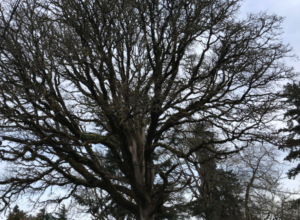by Cathy Schar
 (This is based on an article by Margaret Roach.) Douglas W. Tallamy, an entomologist and longtime professor at the University of Delaware, likes caterpillars. Caterpillars fuel the food web, as his research demonstrates. “There is much going on in your yard that would not be going on if you did not have one or more oak trees gracing your piece of planet earth,” he writes in his new book, THE NATURE OF OAKS: THE RICH ECOLOGY OF OUR MOST ESSENTIAL NATIVE TREES.
(This is based on an article by Margaret Roach.) Douglas W. Tallamy, an entomologist and longtime professor at the University of Delaware, likes caterpillars. Caterpillars fuel the food web, as his research demonstrates. “There is much going on in your yard that would not be going on if you did not have one or more oak trees gracing your piece of planet earth,” he writes in his new book, THE NATURE OF OAKS: THE RICH ECOLOGY OF OUR MOST ESSENTIAL NATIVE TREES.
He calls caterpillars “repurposed leaves that walk.” His previous books, including NATURES BEST HOPE, published in 2020, has caterpillars as main characters. “They are so important, critically important, in running our ecosystems, and that’s what attracts me. Oaks are not just another plant.” And they have impressive credentials:
Oak trees support 897 caterpillar species in the US. Of the food eaten by insects, birds and other animals, 75% comes from a few key genera of trees—and oaks lead the list. Birds forage longer in oaks (which again is often about caterpillars—a high-value food especially during breeding season, when they are prime baby food). Further, there ought to be an ode to oak leaf litter, so don’t start cleanup too early. The decomposers disappear if oak leaf litter disappears, as well as the fungi and bacteria many decomposers eat and the mycorrhizae that enable plant roots to absorb the nutrients they need. Other superpowers, which we gardeners will appreciate, pertain to invasive weeds,which are deterred, as are various destructive worms.
 Mr. Tallamy’s call to action: convincing us to plant oaks, preferably from acorns. “Acorns are easy, free & plentiful,” he writes, “and they will grow into healthier trees than ifyou transplant established trees. Rather than pulling up those volunteer seedlings, why not leave one in place and protect it from animals, if necessary, with a wire cage while it gains a foothold. Several trees spaced 10 feet apart will interlock their roots, forming a grove, each better anchored than it would be standing alone.”
Mr. Tallamy’s call to action: convincing us to plant oaks, preferably from acorns. “Acorns are easy, free & plentiful,” he writes, “and they will grow into healthier trees than ifyou transplant established trees. Rather than pulling up those volunteer seedlings, why not leave one in place and protect it from animals, if necessary, with a wire cage while it gains a foothold. Several trees spaced 10 feet apart will interlock their roots, forming a grove, each better anchored than it would be standing alone.”